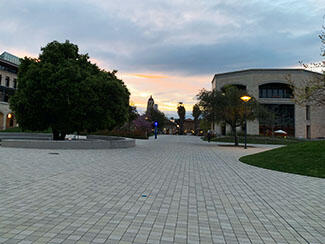
Pathways to Carbon Neutrality in California: The Bioenergy Opportunity
NVIDIA AUDITORIUM AND VIA LIVESTREAM
Pathways to Carbon Neutrality in California: The Bioenergy Opportunity
California has an abundance of biomass-based resources derived from the state’s diverse agricultural, urban waste and forest streams. These biomass resource types can be converted to bioenergy products that have many potential applications across California's energy system. However, today, most of the carbon from this biomass returns to the atmosphere as carbon dioxide or methane as the biomass naturally decays or gets burned, representing an opportunity lost for bioenergy production.
We analyze the types, quantities, and the emission reduction potential of biomass resources available for bioenergy production currently, in 2025 and in 2045 as a result of existing practices and policies in California. We find that landfill gas holds the greatest energy potential currently while MSW and agricultural residues hold the most significant potential in 2045. We also find that if the total gross waste biomass potential were utilized for energy production, California’s total emissions could be reduced by 1-8%, depending on the conversion process and the end-product.
This study is one of the eight studies published as a part of the Stanford Center for Carbon Storage effort to inform the discussion on pathways to carbon neutrality in California. Its results will be used in an integrated assessment model in the upcoming year to create decarbonization scenarios for the state.
Bio: Anela Arifi is an E-IPER Ph.D. student and a Knight-Hennessy scholar co-advised by Chris Field and Ines Azevedo. Her research focuses on the role of biomass energy in energy system decarbonization. She received her bachelor’s degree from Dartmouth College where she worked on designing biomass conversion processes that would aid in sustainably setting biofuels in a circular economy paradigm. While in her home country, Bosnia and Herzegovina, Anela developed biomass energy systems for rural communities using chicken feathers and municipal waste as feedstock. To raise awareness about energy poverty, she spoke at TEDWomen and addressed the UN.
Engineering the Electrochemical Reaction Microenvironment to Valorize Nitrate-Polluted Wastewaters
The nitrogen cycle is in urgent need of reinvention: Haber-Bosch fertilizer production has outpaced removal of N from wastewater, leading to continuous losses from the nitrogen economy and exerting great burden on the environment. As the most prevalent waterborne N pollutant, nitrate jeopardizes the health of ecosystems and human beings.
By selectively producing ammonia, electrochemical nitrate reduction reaction (NO3RR) can directly transform nitrate pollutants into widely used commodity chemicals and fertilizers, thus balancing the nitrogen cycle while reducing energy consumption from the traditional Haber-Bosch process. The reaction microenvironment that is located at the interfacial region between the electrode and the electrolyte has been found to significantly impact the activity and selectivity of electrocatalytic reactions.
Using a combination of electrochemical testing, advanced characterization and computation, we investigated both the electrocatalyst evolution and electrolyte properties in the NO3RR reaction microenvironment and provided engineering strategies to optimize ammonia production.
Bio: Jinyu Guo is a fourth-year PhD student in Chemical Engineering and works in the Tarpeh Group. Her research focuses on understanding the molecular mechanisms in electrochemical processes of valorizing waterborne nitrogen pollutants. She received her B.S. in Chemical Engineering from Tianjin University in 2019.